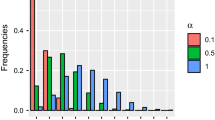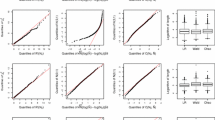Abstract
Consider the removal experiment used to estimate population sizes. Statistical methods towards testing the homogeneity of capture probabilities of animals, including a graphical diagnostic and a formal test, are presented and illustrated by real biological examples. Simulation is used to assess the test and compare it with the χ2 test.
Similar content being viewed by others
References
Borchers DL, Buckland ST and Zucchini W (2002). Estimating animal abundance. Springer-Verlag, London
Buckland ST, Goudie IBJ and Borchers DL (2000). Widelife population assessment: past developments and future directions. Biometrics 56: 1–12
Carle FL and Strub MR (1978). A new method for estimating population size from removal data. Biometrics 34: 621–630
Lee SM and Chao A (1994). Estimating population size via sample coverage for closed capture–recapture models. Biometrics 50: 88–97
Lindsay BG (1995) Mixture models: theory, geometry and applications. Institute of Mathematical Statistics, Hayward, California
Lindsay BG and Roeder K (1992). Residual diagnotics for mixture models. J Am Stat Assoc 87: 785–794
Mao CX (2004). Prediction the conditional probability of discovering a new class. J Am Stat Assoc 99: 1108–1118
Mao CX and Lindsay BG (2002). Diagnostics for the heterogeneity of inclusion probabilities in a Bernoulli census. Indian J Stat 64: 763–819
Mao CX and Lindsay BG (2003). Tests and diagnostics for heterogeneity for the species problem. Comput Statist Data Anal 41: 389–398
Moran PAP (1951). A mathematical theory of animal trapping. Biometrika 38: 307–311
Neyman J and Scott EL (1966). On the use of C(α) optimal tests of composite hypothesis. Bulletin de l’Institut International de Statistique 41(I): 477–497
Norris JLI and Pollock KH (1996). Nonparametric MLE under two closed capture–recapture models with heterogeneity. Biometrics 52: 639–649
Otis DL, Burnham KP, White GC and Anderson DR (1978). Statistical inference from capture data on closed animal populations. Wildl Monogr 62: 1–135
Ricker WE (1975). Computation and interpretation of biological statistics of fish populations. Bull Fishe Aquat Board Canada 191: 1–382
Schwarz CJ and Seber GAF (1999). A review of estimating animal abundance III. Stat Sci 14: 427–456
Wang YG (1999). Estimating equations for removed data analysis. Biometrics 55: 1263–1268
Zippin C (1956). An evaluation of the removal method of estimating animal populations. Biometrics 12: 163–189
Author information
Authors and Affiliations
Corresponding author
Rights and permissions
About this article
Cite this article
Mao, C.X. Testing homogeneity of capture probabilities of animals in a removal experiment. Environ Ecol Stat 14, 473–481 (2007). https://doi.org/10.1007/s10651-007-0054-8
Received:
Revised:
Published:
Issue Date:
DOI: https://doi.org/10.1007/s10651-007-0054-8




